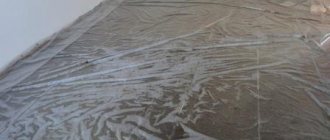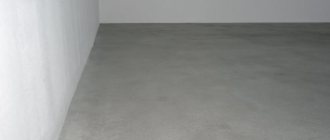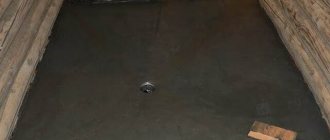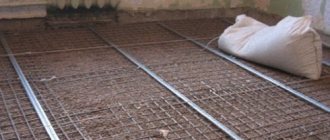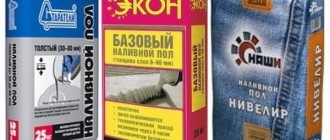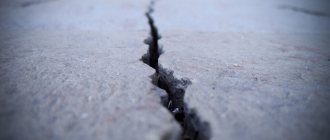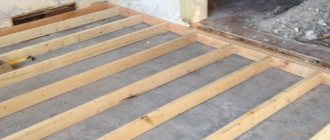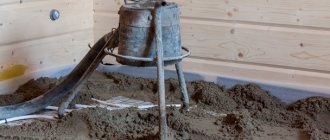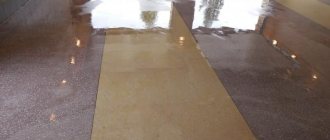1566
Foam concrete differs from ordinary concrete in that it contains a foaming agent. Due to this, the material turns out to be cellular, with many closed pores. Advantages of cellular concrete:
- high thermal insulation properties (foam concrete floors have a temperature 2 - 4 degrees higher than simple concrete);
- better sound insulation;
- less weight, which means low load on the foundation;
- less cement consumption, that is, reduced transportation costs;
- drilling capability;
- Possibility of pouring onto uneven, damaged, multi-level surfaces;
- service life of at least 50 years.
Disadvantages of foam concrete:
- low frost resistance;
- water permeability;
- significant shrinkage;
- low strength compared to traditional concrete;
- low fluidity when pouring.
Foam concrete
This material is used for pouring floors and making foam blocks. The downside of aerated concrete screeds is the need to use special equipment to create and supply foam.
Screed options
Foam concrete screeds come in the following types:
- combined, i.e. using concrete of different densities;
- monolithic, determined by the use of concrete of the same density.
Return to contents
Using foam concrete of the same density
A foam concrete floor using concrete of the same density is economically beneficial. Used in structures with limited load on load-bearing elements of buildings. Monolithic foam concrete is used if it is necessary to create a “warm floor”. Due to the low heat transfer of this type of screed, the heat energy consumption for heating the building elements of buildings is reduced. Thus, the use of aerated concrete floor tensioning can reduce the cost of additional heating equipment.
Return to contents
With different densities
A foam concrete floor using concrete of different densities has a highly effective property. The combined method consists of a heat-insulating material with a density of about 400 kg/m3 and a conventional layer of concrete, the density of which is allowed from 600 to 1200 kg/m3. The thickness of each layer is determined individually for each case.
Return to contents
The principle of pouring foam concrete using technology into permanent formwork
The use of permanent formwork made from a special material (magnesium glass with a wall thickness of up to 4.5 cm) for pouring allows our company to produce monolithic foam concrete with undeniable advantages over other methods of pouring concrete concrete.
So, the advantages of foam concrete structures created using glass-magnesium sheets as formwork are as follows:
- They have high thermal conductivity (2.5 times higher than that of brick).
- They have good vapor permeability (indicators are at the level of wood).
- Not fire hazardous and not susceptible to rotting.
- There is no heat loss at masonry joints when using bricks or blocks (on average, the heat loss when using these types of materials is 25%).
- When using SML, the finished surface of the structure has ideal adhesion and any finishing can be done.
- Thanks to the combination of vapor-permeable and thermal insulation qualities, an ideal microclimate is created in the room.
Advantages of using foam concrete for screed
Advantages of foam concrete screeds:
- Sound insulation and thermal insulation in foam concrete ensures comfortable living in the room where such a screed is used.
- Ease of use. There are no installation difficulties during the work, because its construction does not require special equipment or transportation.
- Ease of manufacture. The solution can be prepared at the construction site.
- The speed of preparing the solution reduces the total time for construction work.
- Possibility of connection with various surfaces.
- There is no need for foundation preparatory work.
- With the help of this building material, it became possible to hide defects, unevenness and differences in the foundations.
- Thermal insulation benefits allow you to retain heat due to the porous structure of the material. This reduces heating costs and creates a comfortable temperature in the room.
- The lightness of the material allows you to reduce the load on the base of structures.
Return to contents
Construction of a cottage from foam concrete. Pouring foam concrete for various construction projects
Pouring roofs and floors with foam concreteOne of the most labor-intensive operations in construction is the creation of leveling cement-sand screeds. Due to the high average density of such screeds (about 2000 kg/m3), the load on the floors, walls and foundations of buildings increases. Due to the relatively high coefficient of thermal conductivity (0.6 W/(m*C), floors that are subsequently made on such a base are “cold.” The use of foam concrete screeds greatly facilitates the work and improves the thermal conductivity and weight characteristics density of about 700 kg/m3. In this case, the loads are reduced by 60%, sound insulation is increased due to the porous structure of foam concrete, the temperature on the surface of the base increases by 2-5 0 C due to a decrease in the thermal conductivity coefficient by 2 -2.5 times, which significantly increases the comfort of the floor.
Method of pouring floors and roofs with foam concrete
First, logs must be made on the floor or roof; the maximum size of the space without logs into which foam concrete is poured is 2x2 meters. The surface on which foam concrete will be poured must be cleaned of debris and dust and moistened. Moisturizing helps avoid subsequent subsidence and cracking. Foam concrete has low self-leveling and flow rates, so after pouring the floor, the surface must be leveled with planks along the guides. They take care of a poured foam concrete floor or roof, just like a regular concrete one - water it and do not dry it out.
After the foam concrete has risen, you can apply a top reinforcing layer or lay parquet, laminate, wood or floor tiles. You cannot lay soft and “walking” coverings such as linoleum, etc. directly on foam concrete.
The thickness of the foam concrete layer for the base of the floors is 30-50 mm. It is possible to apply a layer up to 100 mm. The minimum thickness of the foam concrete layer when laying it on floor slabs is 30 mm. The floor structure is calculated and designed for each specific object, depending on its purpose.
For the installation of floors and ceilings, foam concrete must meet the requirements of GOST 25485 - 89 “Cellular Concrete”, and the quality of the floor surface must meet the requirements of GOST 13.015.0 - 83. The hardening accelerator significantly reduces the standing time and, accordingly, speeds up the work.
When cracks appear, polypropylene fiber is used to prevent them. Fiber is added in quantities from 0.5 to 1 kg per 1 cubic meter. poured foam concrete.
Manufacturing technology
The following materials and equipment are used for the manufacture of concrete screed:
- filler in the form of quarry fine sand;
- water;
- sand;
- cement;
- Portland cement;
- foaming agent;
- autoclave;
- pump;
- concrete mixer;
- steam generator
The production of concrete screed consists of the following steps:
prepare the solution;
- lay the mixture;
- provide care for concrete screed.
To prepare the solution you will need one part cement and three parts sand. Pour water into the combined ingredients and begin stirring the mixture until a homogeneous state is formed. When using a concrete mixer, pour water into it and turn it on. Then sand and cement are poured. Mixing takes about five minutes. After the specified time has passed, look at the thickness of the solution and, if necessary, add more water.
The mixture is poured continuously and evenly. To make the concrete surface even, beacons are used, along which the floor screed is carried out. After applying the solution, it must be leveled; this is done using a pipe cut or a spatula.
It is important to ensure that the coated concrete surface is properly maintained. Foam concrete screed does not like exposure to high temperatures and direct sunlight. Due to the sun's rays hitting the cellular concrete, moisture evaporates, which leads to cracking of the surface. To prevent such consequences, the poured solution is covered with a film and periodically irrigated with water.
It is not recommended to start using a poured floor after it has not been sufficiently cured. It is a mistaken belief that you can walk on a floor that is not completely frozen after three days. Early use of foam concrete screed can disrupt the quality characteristics of the building material and compromise the strength of the entire structure.
Return to contents
How to insulate a house with foam concrete?
The barrel for mixing foam concrete consisted of thick sheets of iron welded together at the seams. As the owner of his creation, Oleg, told me, dense metal layers were previously bent into an arc on a special press in the workshop.
I will say that in appearance the concrete mixer described was practically no different from the industrial equipment that construction crews professionally use.
The scheme for insulating the floor, ceiling or wall ceilings, respectively, is also not unique or new, but, as in the case of professional work, has its own logic and strict sequence of development.
Preparation of the floor before pouring foam concrete mortar, in particular, includes insulation and placement of beacons. To ensure that foam concrete is poured evenly on the floor surface, beacons are used in the form of a stretched line. Using the marks in different parts of the threads or fishing line, you can record the required amount of solution to be poured. Of course, hardened foam concrete is not the final layer of the floor surface. Therefore, according to the rules, most often the floor is also screeded after insulation.
After preparing the surface, the process of mixing foam concrete in a barrel occurs. The main ingredients included were: Eurocement, foam and water. All this is mixed in a concrete mixer for several minutes and supplied with air through a hose. I note that in our case we used a fire hose, as it is very durable and elastic. In addition, washing it and cleaning it after work is a pleasure.
Preparing the ceiling or walls before insulation is a much more complex process than preparing the floor. If the ceiling between floors in a house is made poorly, for example, from various wooden blocks, then they have to be strengthened with screws, having previously been covered with wooden plywood. Concrete floors, as a rule, are easier to prepare for insulation: it only requires insulating the surface with a special film.
Insulation of floors, walls and ceilings is a responsible, complex and time-consuming process. It is very important that during the process of feeding foam concrete through the hose, excess foam concrete is not wasted. Waste of material is the owner's money. In addition, the wrong ratio of components can spoil the quality of the original product.
The end result, if all the rules are followed in good faith, will pleasantly please the owner of the house. Foam concrete hardens very quickly, so the room will become very warm within a few days.
I admit that foam concrete is now not a panacea in the construction industry, since recently cheaper, lighter, high-quality materials for insulation have been used. However, thanks to its environmentally friendly components and low cost, foam concrete can still compete in the construction services market.
Tags: useful tips, building materials, household, insulation, construction, house
How to make a floor screed from self-leveling foam concrete with your own hands
Foam concrete screed, which has been increasingly used recently for leveling floors, significantly simplifies the work process in comparison with the use of cement-sand mixtures. Floors equipped with this technology not only have a significantly lower cost, but also a number of other important advantages.
Types of screeds and their purpose
Aerated concrete screed comes in two variants:
- monolithic, in which the surface is filled with a composition of the same density;
- combined, where foam concrete is the bottom heat-insulating coating.
The monolith obtained in the first case has two significant advantages at a relatively low price:
1. Low thermal conductivity, due to which it is possible to achieve a reduction in costs for heating equipment during the operation of the premises.
2. Light weight.
This type of concreting has found wide application in buildings that have restrictions on the maximum load on load-bearing structural elements. Monolithic foam concrete screeds are indispensable when installing floor heating systems.
No less popular is the combined technology - pouring in several layers. In this case, the first is made of plain concrete with a density of 600-1200 kg/m3, and the second is made of heat-insulating concrete with a density of 400 kg/m3. This two-layer design provides higher performance properties. The thickness of the layers is selected individually in each case.
As an alternative to the above methods, many developers prefer laying ready-made foam concrete blocks from trusted manufacturers. This option allows you to prevent mistakes associated with preparing the mortar yourself, as well as save on the purchase or rental of special equipment.
Pros and cons of using foam concrete for screed
The main advantages are:
- Durability – service life is at least 50 years.
- High degree of thermal insulation, allowing to reduce the cost of heating the room.
- Excellent soundproofing ability.
- Lightweight, ensuring low load on supporting structures.
- Low material consumption.
- There is no need to prepare the base - a foam concrete screed ideally smoothes out any surface unevenness.
- The ability to prepare the solution immediately before concreting directly on site, which helps to significantly reduce the cost of transportation.
- High speed of work.
A screed made of self-leveling foam concrete is indispensable in cases where:
- the load-bearing capacity of an already constructed building has limitations;
- there is a desire to save on building a foundation;
- it is necessary to provide effective protection against heat loss and high noise insulation.
The main disadvantage is the use of expensive equipment. However, you can do without it by using a ready-made purchased unit.
Execution technology
The solution for pouring foam concrete floors includes the following components:
- water;
- filler - fine sand, crushed stone or scrap concrete;
- Portland cement (M300 or M400);
- foaming agent
The following equipment is used to carry out the work:
- autoclave;
- steam generator;
- pump;
- concrete mixer.
The mixture is prepared using one of the following technologies:
- classical, in which the solution and foam are simultaneously fed under pressure into the drum;
- mineralization, when the entire process is carried out without the use of water - dry CPS is poured into a tank, where foam is continuously supplied using a special installation;
- barotechnology, based on preparing a mixture for pouring a floor in a sealed container while supplying air under pressure inside it.
Foam concrete screed is performed in the following sequence:
- Logs are placed on the base in increments of up to 2 meters.
- Beacons are placed at a distance of no more than one meter from each other.
- The finished solution is poured and leveled using special devices.
- To prevent the monolith from drying out and cracking, the surface is periodically watered with water during drying.
- The finished floor screed is covered with a reinforcing layer, which can be tiles or a self-leveling mixture.
Cost of work
In most cases, foam concrete floors are poured by specialists. Moreover, the price depends not only on the thickness, but also on the quality of the materials used. Before contacting a particular company, you should read reviews on the Internet and ask friends and acquaintances.
The cost in Moscow varies from 350 to 450 rubles per 1 m2 with a pouring height of no more than 40-50 mm. If you need to install a self-leveling floor with a thickness of 50 to 100 mm, then you will have to pay 500-1000 rubles per square meter of area.
Author: Valentin Tokarev
| Related articles: | |
| Prices for laying foam concrete blocks per 1 m3 Characteristics of foam concrete blocks measuring 20x30x60 The cost of building a turnkey foam concrete garage | |
Using foam concrete for pouring floors and roofs
Justification for using foam concrete for pouring and leveling floors and roofs
One of the most labor-intensive operations in construction is the creation of leveling cement-sand screeds. Due to the high average density of such screeds (about 2000 kg/m3), the load on the floors, walls and foundations of buildings increases. Due to the relatively high thermal conductivity coefficient (0.6 W/(m o C)), floors that are subsequently made on such a base are “cold”. The use of foam concrete screeds with a density of about 700 kg/m3 greatly facilitates work and improves thermal conductivity and weight characteristics. In this case, the loads are reduced by 60%, sound insulation is increased due to the porous structure of foam concrete, the temperature on the surface of the base increases by 2-5 oC due to a decrease in the thermal conductivity coefficient by 2-2.5 times, which significantly increases the comfort of the floor.
Method of pouring floors and roofs with foam concrete
Floors are poured using a Sunny-014 mobile installation with a capacity of 1-2 m3/hour with foam concrete supplied through hoses up to 20 meters horizontally and up to 5 meters vertically. First, logs must be made on the floor; the maximum size of the space without logs into which foam concrete is poured is 2x2 meters. Foam concrete has low levels of self-leveling and fluidity, so after pouring the floor, the surface must be leveled with planks along the guides. They take care of a poured foam concrete floor or roof, just like ordinary concrete ones - water and do not dry out. After the foam concrete has risen, the top reinforcing layer can be applied. This could be floor tiles, a self-leveling mixture (Vetonit, Plitonit - write, we will provide supplies at low prices :). You cannot lay soft and “walking” coverings - parquet, wood, linoleum, etc. directly on foam concrete. The thickness of the foam concrete layer for the base of the floors is 30-50 mm. It is possible to apply a layer up to 100 mm. The minimum thickness of the foam concrete layer when laying it on floor slabs is 30 mm. The floor structure is calculated and designed for each specific object, depending on its purpose. For the installation of floors and ceilings, foam concrete must meet the requirements of GOST 25485 - 89 “Cellular Concrete”, and the quality of the floor surface must meet the requirements of GOST 13.015.0 - 83. The hardening accelerator significantly reduces the rise time and accordingly speeds up the work.
Foam concrete screed pros and cons
Features, advantages, technology of pouring foam concrete screed
Foam concrete differs from ordinary concrete in that it contains a foaming agent. Due to this, the material turns out to be cellular, with many closed pores. Advantages of cellular concrete:
- high thermal insulation properties (foam concrete floors have a temperature 2 - 4 degrees higher than simple concrete ones),
- better sound insulation,
- less weight, which means low load on the foundation,
- lower cement consumption, that is, reduced transportation costs,
- possibility of drilling,
- Possibility of pouring onto uneven, damaged, multi-level surfaces,
- service life of at least 50 years.
- low frost resistance,
- water permeability
- significant shrinkage,
- low strength compared to traditional concrete,
- low fluidity when pouring.
Foam concrete
This material is used for pouring floors and making foam blocks. The downside of aerated concrete screeds is the need to use special equipment to create and supply foam.
Production of foam concrete
- cement grade M400 or M500,
- natural or crushed sand,
- water,
- foaming agent
Protein foaming agent
The density of the finished product depends on the ratio of the components. Cellular concrete is made by mixing ready-made stable foam and concrete mortar.
Special equipment for producing foam concrete:
- Foam generator for producing foam. This is a device in which air, water and a foaming agent are mixed. You can make a foam generator at home yourself.
- Compressor. It is needed to compress air and supply it to the foam generator.
- Concrete mixer. Instead, you can use a large container and a shovel.
Equipment for the production of cellular concrete
Important! The maximum permissible volume of foam is 1.5 liters per 1 cubic meter. m of foam concrete. Exceeding this leads to excessive consumption of foaming agent, an increase in hardening time and a decrease in the strength of the finished product.
There are three methods for producing cellular concrete:
- Classical. Foam is fed into the finished cement-water solution from a foam generator.
- Barotechnology. This method does not require the use of a foam generator. First, water is poured into the container, then a foaming agent is added. Cement and sand are added. Air is pumped under pressure.
- Mineralization. Foam concrete is produced using this method without adding water. The finished foam is fed continuously into a container with dry cement and sand.
Methods for making foam concrete screeds
Foam concrete screed is made in two ways:
- Monolithic - made of material of uniform density (800 kg per cubic meter).
- Combined - from two layers of cellular concrete of different densities. The first layer is heat-insulating (density 300 - 500 kg per cubic meter, the second layer is the main layer (density 600 - 1200 kg per cubic meter).
- Install logs on the base of the floor in 2 m increments.
- Place beacons from a metal profile in 1 m increments.
- Pour in the prepared solution. Level its surface using the beacon rule.
Pouring cellular concrete
- After finishing pouring, pour water over the screed.
- After the new foam concrete floor has hardened, apply a self-leveling mixture to its surface.
Application of self-leveling mixture Finished floor
Conclusion
Filling the floor with foam concrete is advisable in rooms where an increased level of heat and sound insulation is required. If you have minimal experience in construction work and the necessary equipment, you can do it yourself.
Advantages of foam concrete screed
The procedure for making foam concrete screeds is in great demand in the construction of floors. It significantly facilitates work and improves the weight and thermal conductivity of screeds with a density of 600-1200 kg/m³. Thanks to the porosity of the material, the pressure on the load-bearing parts of the building is reduced by up to 40%, and the insulation of heat and sounds is improved.
Foam concrete floor diagram.
It is possible not only to fill the floor with foam concrete. Using foam blocks for flooring is also no less popular. Their production became possible after the development and introduction of expanded clay concrete blocks.
Screed arrangement options
The combined method of producing foam concrete screed has a great effect. Here, foam concrete acts as a heat-insulating material (300-500 kg/m³) from below, and the coating on top is a regular screed with a layer of 3-5 cm. The required thickness for layers of material is calculated for a particular case.
Foam concrete floor diagram.
Foam concrete floors of the same density are another way. When reconstructing residential and industrial premises, foam concrete is used, the density of which is 800 kg/m³. This makes it possible to level the floor surface and immediately insulate it.
Using monolithic foam concrete to screed (10-20 cm) floors in a rough manner, there are benefits from the point of view of economics and technology in comparison with concrete or cement-sand screed with reinforcement (3 times less load and higher heat-insulating properties). Therefore, the procedure for filling floors with foam concrete becomes indispensable where requirements are imposed to limit the influence of weight on the load-bearing parts of the house.
Advantages of using foam concrete for screed
Pouring foam concrete has advantages:
Installation diagram of foam concrete floors.
- due to the foam concrete composition, a homogeneous monolith layer with a given level is formed on the floor surface, eliminating uneven floors and accompanying differences in heights,
- transportation costs for delivering materials (cement in bags and sand) to the construction site are minimal,
- a simple way to prepare the solution directly at the construction site and supply it to the pouring area (especially using foam barotechnology),
- low material consumption of foam concrete,
- the speed of the process, which consists of laying 3 m³ of foam concrete material per hour or 100 (or more) m² of floor surface with a layer thickness of 10 cm per day,
- pouring foam concrete does not require mandatory preparation of the base and can be performed on damaged, rough and surfaces with bumps and different levels (laying on uncovered soil is acceptable),
- This type of screed has proven itself in the installation of underfloor heating systems.
Pouring technology
Materials for making screeds:
Foam generator device for foam concrete.
- Portland cement M300 or M400 (320 kg),
- filler - fine quarry sand (200 kg) or waste concrete scrap, crushed gravel and ash and slag,
- foaming agent - either organic or synthetic composition, SDO, low expansion foam - 1.3 l,
- process water (volume is determined by the technology option).
Comparative table of characteristics of foam concrete and ordinary concrete.
- water is poured into a sealed container,
- foaming agent is loaded,
- add other components
- air is pumped into the reservoir under pressure,
- the induced mixture is transported to the pouring site.
Mineralization involves obtaining a potting solution without the use of water. The mixture is prepared as follows:
- continuously feeds foam from the installation,
- a dry mixture of sand and cement is poured into the tank,
- the entire mass is mixed and supplied to the pouring area.
The classic method is the most difficult to technically execute:
- under pressure, the foam is sent into the drum simultaneously with the solution,
- the prepared composition is sent to the pouring area.
- Logs are laid on the base in increments of no more than 2 m.
- Beacons are placed (these can be scraps of plasterboard profiles) with a mandatory distance of 1 m.
- Pour the prepared mixture onto the base.
- Level the mixture with planks along the guides.
- After pouring, the screed is watered to prevent it from drying out.
- When the foam concrete is ready, a reinforcing layer is laid on top of it (it can be a self-leveling mixture or tiles).
The disadvantage of this material for arranging a screed is considered to be the rather high labor intensity of the process of applying the mixture.
But the use of special technology makes the process easier.
